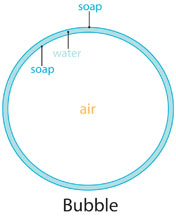Floating Bubbles
Using baking soda and vinegar, you can make ordinary soap bubbles stay afloat.
Watch as the bubbles stay in midair, not sinking or falling to the ground.
What You Need:
- ¼ cup baking soda
- ¾ cup vinegar
- Bubble solution
- Bubble wand
- Large, clear bowl
What You Do:
1. Put the baking soda into the bowl, then slowly pour in the vinegar until the mixture is bubbling quite a lot, but not overflowing.
2. Blow bubbles with the wand into the bowl with the fizzing mixture. The bubbles should float, rather than fall to the surface of the mixture.
What Happened:
When baking soda and vinegar are put together, they create a chemical reaction that fizzes a lot, but also forms a gas called carbon dioxide. Carbon dioxide is slightly heavier than air, which is mostly nitrogen and oxygen. Since the bubbles you blew into the container are filled with air, they float on the layer of carbon dioxide gas that the baking soda and vinegar created.
Soapy Science
If you like, try making your own bubbles with soap and water! This project is best done on a clear, windless day, but when it’s raining outside, try blowing bubbles near the kitchen sink or bathtub.
What You Need:
- ¼ cup of liquid dishwashing soap
- 1 cup of room temperature water
- 2 tablespoons light corn syrup (such as Karo) or 2 tablespoons liquid glycerin
- Spoon
- Baking pan or shallow container
- Bubble wand*
*You can make your own bubble wand using simple household materials. Use a plastic straw, a cardboard carton (such as a small cream or half & half container) with the top and bottom cut off, or a wire hanger or pipe cleaner bent into a circular shape.
What You Do:
In the baking pan, gently stir the corn syrup or glycerin and the dish soap into the water, until well mixed. For best results, cover the bubble solution with plastic wrap and let it sit at room temperature for several hours or overnight. To make the best bubbles, dip your wand into the mixture, slowly pull it out, wait a few seconds, and then blow. How big of a bubble can you make? How many bubbles can you make in one breath?
What Happened:
 Imagine an invisible “bubble”‘ of pure air that is exactly the same size as a bubble you blow using a straw. This invisible bubble would be lighter than the bubble you can see, because it is nothing but air! Though the soap bubbles you have made are filled with air, they are surrounded by soap and water which are heavier than air, and so they float to the ground. The soap mixture on the outside of a bubble is actually made of three very thin layers: soap, water, and another layer of soap. This “sandwich” that is on the outside of a bubble is called a soap film.
Imagine an invisible “bubble”‘ of pure air that is exactly the same size as a bubble you blow using a straw. This invisible bubble would be lighter than the bubble you can see, because it is nothing but air! Though the soap bubbles you have made are filled with air, they are surrounded by soap and water which are heavier than air, and so they float to the ground. The soap mixture on the outside of a bubble is actually made of three very thin layers: soap, water, and another layer of soap. This “sandwich” that is on the outside of a bubble is called a soap film.
You may have noticed that when you blew into the square bubble wand, a spherical or round bubble came out! This is because as you blow air into the soap film, it surrounds the air by taking up the least surface area it can, which is in a perfect sphere shape. If you blow too hard, the soap film on the wand will pop, because it cannot stretch enough to hold that quantity of air.
Why are bubbles so colorful? The light reflecting in the layer of water sandwiched between thin layers of soap makes rainbow patterns! Sunlight is made up of all colors of light mixed together. When bright light bounces off tiny drops of water, it breaks into colored rainbows of red, orange, yellow, green, blue, indigo and violet.





